Why Not Start the New Year with a Powamu Festival?
By Alice Osborne
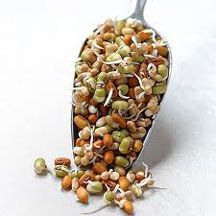 Did you know that in January or early February the Hopi Indians (from the southwest United States) have a festival devoted entirely to bean sprouts? The bean sprout is a symbol of fertility and prosperity and agrarian societies depend heavily on successful seed and bean sprouting - which obviously leads to abundant crops and a bountiful harvest.
Did you know that in January or early February the Hopi Indians (from the southwest United States) have a festival devoted entirely to bean sprouts? The bean sprout is a symbol of fertility and prosperity and agrarian societies depend heavily on successful seed and bean sprouting - which obviously leads to abundant crops and a bountiful harvest.
The Powamu Festival, the Hopi's name for this annual event, includes lots of good food, games, and of course, ceremonies and celebrating. So why am I bringing it up? Well, January and February tend to be rather bleak months that seem extra LONG. So I thought, hey, why not start our own tradition and learn to sprout beans and then plan a fun meal around them. Invite the neighbors in and add a new dimension to your new year.
 This said, let's look first at why we ought to sprout beans in the first place: Many people can't tolerate grains, seeds, nuts and legumes, or products such as breads, cakes or bean dishes made from them. Tell-tale signs of this intolerance are of course, flatulence, indigestion, and a heavy feeling after eating them.
This said, let's look first at why we ought to sprout beans in the first place: Many people can't tolerate grains, seeds, nuts and legumes, or products such as breads, cakes or bean dishes made from them. Tell-tale signs of this intolerance are of course, flatulence, indigestion, and a heavy feeling after eating them.
Grains/seeds and legumes/beans contain enzyme inhibitors, which keep them dormant until they are soaked and start to sprout. They also contain phytic acid (an organic acid in which phosphorous is bound) in the outer layer or bran, and a variety of toxins to protect them from being eaten by mammals, including humans. These enzyme inhibitors, phytic acid and other toxins make dry grains, seeds and legumes indigestible. Phytic acid also reacts with many essential minerals, such as calcium, magnesium, copper, iron and especially zinc, and stops their absorption in the intestines.
Early humans did not evolve with grains or legumes as part of their diet. It is only in the last 10,000 years since the advent of agriculture, that humans have started to eat them. Grains and legumes are a "new food" and the human body has not fully adapted to digesting them. No other primate eats them, as a matter of fact.
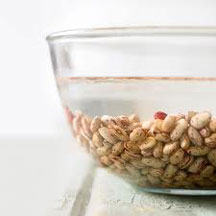 So they should be soaked. Soaking neutralizes the enzyme inhibitors present in dry grains, seeds and legumes, and starts the production of numerous beneficial enzymes. As they soak, the enzymes, lactobacilli and other helpful organisms break down and neutralize the phytic acid. As little as seven hours soaking in water removes most of the phytic acid. Soaking, fermenting and sprouting also breaks down gluten and other difficult-to-digest proteins into simpler components that are more easily absorbed. However, not all toxins are removed, with wheat and some legumes being the worst affected.
So they should be soaked. Soaking neutralizes the enzyme inhibitors present in dry grains, seeds and legumes, and starts the production of numerous beneficial enzymes. As they soak, the enzymes, lactobacilli and other helpful organisms break down and neutralize the phytic acid. As little as seven hours soaking in water removes most of the phytic acid. Soaking, fermenting and sprouting also breaks down gluten and other difficult-to-digest proteins into simpler components that are more easily absorbed. However, not all toxins are removed, with wheat and some legumes being the worst affected.
A diet with grains or legumes that have not been sprouted or soaked can lead to serious mineral deficiencies, bone loss, and digestive problems such as reflux, bloating, food allergies, irritable bowel and other forms of weak digestion.
 Breads and other products made from flour that has not been risen or soaked for at least seven hours have a similar effect. Most commercial breads, pastries, biscuits etc are made from un-soaked flour, by the way.
Breads and other products made from flour that has not been risen or soaked for at least seven hours have a similar effect. Most commercial breads, pastries, biscuits etc are made from un-soaked flour, by the way.
And since they're now soaked, why not sprout them? The toxins in many legumes do not appear in their sprouts. Sprouts are a living, enzyme-rich food, natural and low in calories. Their vitamin A content will double, various B group vitamins will be 5 to 10 times higher, and vitamin C will increase by a similar order. Their protein content becomes easily digestible, and rich new nutrients such as enzymes and phyto-chemicals are created. And sprouts contain significant amounts of bio-available calcium, iron and zinc.
 When a dormant seed or bean sprouts, its starch is converted into simple sugars, and long chain proteins are split into smaller, easily-digestible molecules. Sprouted beans and seeds are like a pre-digested food.
When a dormant seed or bean sprouts, its starch is converted into simple sugars, and long chain proteins are split into smaller, easily-digestible molecules. Sprouted beans and seeds are like a pre-digested food.
Best sprouting results are usually with garbanzo beans (chickpeas), wheat and rye berries, sunflower seeds and mung beans. Garbanzo beans are the most digestible of the beans. When sprouted with 1-2 cm tails, most of their enzyme inhibitors are inactivated. This is why they are the most widely used raw bean in several traditional cuisines, particularly around the Mediterranean as a base for humus.
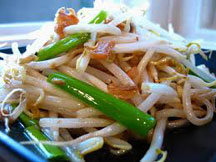 Mung beans make an excellent sprout, and are used widely in Chinese cooking. However, it's the sprouts and not the beans that are used, and the sprouts are often stir-fried.
Mung beans make an excellent sprout, and are used widely in Chinese cooking. However, it's the sprouts and not the beans that are used, and the sprouts are often stir-fried.
First, pick through and discard any broken, moldy, discolored or disfigured seeds. In particular, try to remove black, dark brown or green colored moldy seeds. They can contain harmful toxins that you would want to avoid, whether you are sprouting or cooking them.
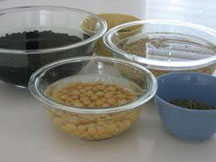 Next, soak them. To sprout a grain, seed or bean, first wash them and then soak them in cool to tepid, filtered or spring water. Soaking time varies between 4 and 12 hours, depending on the size and hardness of the seed. Large hard beans such as garbanzo beans need 12 hours, whereas small soft seeds like buckwheat, amaranth, quinoa and many vegetable seeds only need 4 hours. Rinse them and change the water every couple of hours while they soak.
Next, soak them. To sprout a grain, seed or bean, first wash them and then soak them in cool to tepid, filtered or spring water. Soaking time varies between 4 and 12 hours, depending on the size and hardness of the seed. Large hard beans such as garbanzo beans need 12 hours, whereas small soft seeds like buckwheat, amaranth, quinoa and many vegetable seeds only need 4 hours. Rinse them and change the water every couple of hours while they soak.
Successful sprouting depends on a number of factors including:
• The freshness of the seeds and how "alive" they are (the best source I've found so far is from the website, www.sproutman.com). Many seeds, especially if they have been imported, have been irradiated. Others are just old.
• Whether the seeds are broken, discolored or chemically treated.
• The water's pH, mineral and salt content.
• The water's temperature. Cold climate grains such as oats can even be sprouted in your refrigerator.
• Clean equipment - and you do not need fancy-dancy sprouters. I've been sprouting for years in quart glass canning jars.
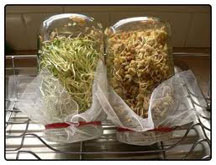 Keep them damp. After the initial soaking, keep the seeds damp. I put them in a large sieve, and rinse them under the tap a couple of times a day. You can also put them in a jar, with a piece of cheese cloth over the top, tied with a string or rubber band. The seeds need to be kept damp and aired, but not wet, otherwise there is a chance of mold or spoiling. Some seeds, such as sunflower, start to sprout in a few hours. Others take more than a day. Within 2 to 5 days, bigger seeds, nuts and beans are ready. They are ready when the root (not the shoot, which is longer) is the length of the seed.
Keep them damp. After the initial soaking, keep the seeds damp. I put them in a large sieve, and rinse them under the tap a couple of times a day. You can also put them in a jar, with a piece of cheese cloth over the top, tied with a string or rubber band. The seeds need to be kept damp and aired, but not wet, otherwise there is a chance of mold or spoiling. Some seeds, such as sunflower, start to sprout in a few hours. Others take more than a day. Within 2 to 5 days, bigger seeds, nuts and beans are ready. They are ready when the root (not the shoot, which is longer) is the length of the seed.
I have had sprouts starting in 8 hours using top quality sunflower seeds. At the other extreme, large cannelloni beans can take two or more days to begin. Keep your sprouting seeds and grains out of full sunlight. Natural light is OK, but full sunlight will encourage leafing.
 And what to do with sprouts? Try keeping two containers of sprouts in your fridge, especially in the summer. Sprouts are the base for all sorts of delectable pates and raw food recipes, and provide a colorful and living addition to any dish - particularly salads. I also add them to my green smoothies.
And what to do with sprouts? Try keeping two containers of sprouts in your fridge, especially in the summer. Sprouts are the base for all sorts of delectable pates and raw food recipes, and provide a colorful and living addition to any dish - particularly salads. I also add them to my green smoothies.
 As mentioned, stir-frying is a great way to include them in your diet, and stir fry could make a really fun company dinner. They're also terrific in soups and stews - another great idea for a winter time meal. So think seriously about treating yourself, friends, and family to a night of Powamu. What the heck, we could all use a bit of prosperity this coming year!
As mentioned, stir-frying is a great way to include them in your diet, and stir fry could make a really fun company dinner. They're also terrific in soups and stews - another great idea for a winter time meal. So think seriously about treating yourself, friends, and family to a night of Powamu. What the heck, we could all use a bit of prosperity this coming year!
Sources:
www.rawbodyandsoul.blogspot.com
www.naturalremedies.org
www.deliciousmagazine.co.uk
www.calorielab.com
www.seriouseats.com
www.squawkfox.com
www.adkjerseygirl.wordpress.com
www.6inthemorningside.com
www.ifood.tv

